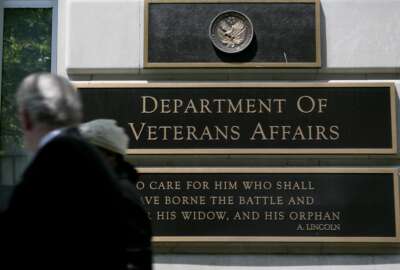

Hubbard Radio Washington DC, LLC. All rights reserved. This website is not intended for users located within the European Economic Area.
The National Nurses Organizing Committee and National Nurses United at Veterans Affairs have signed a three-year contract. It covers more than 14,000 RNs at 2...
The National Nurses Organizing Committee and National Nurses United at Veterans Affairs have signed a three-year contract. It covers more than 14,000 RNs at 23 VA hospitals. Negotiations spanned nearly a decade and two president’s administrations. For details, Federal Drive with Tom Temin spoke to organizing committee chair Irma Westmoreland.
Interview Transcript:
Irma Westmoreland This contract began bargaining this contract in 2013. The notice that we wanted to do it, we actually completed the bargaining and we went to bargaining in late 2016. We finished in 2017. We did all the ratifications, got it ready to go to the secretary. And in 2018, the then-secretary of the VA, Robert Wilkie, denied that 375 provisions of the contract, even as illegal provisions, even though 275 of them had been in the contract since 2003. And so we did a lot of court battles back and forth, back and forth. And then bottom line is, when President Biden came in, he said, let’s go back to the table and see if we can get some of this stuff worked out with the VA, with all of the national unions in their contracts that were hung up. And so we have been going back and forth with the VA just trying to identify and resolve any issues that we could. And so we finally finished everything and we signed the contract in Durham last week.
Eric White And what has been going on since then. Before the agreement was signed.
Irma Westmoreland Well, we haven’t stopped working. We haven’t stopped working. We just didn’t have our contract when over a year from year from year 2012. So this is 2023 and we have been working with a contract that was from 2012 until this one was signed. And although this one was signed in 2023, it was actually negotiated in 2017. And so the contract that we have now, although it’s got some good new updates for us, it is from 2017. And so we’re going to have to look forward to three years from now renegotiating a contract that covers all the changes, like all the things that happened through COVID and all the things that came to light, of all the things that people might need. But we have about 52 articles in our contract that cover all the things from like how often do we do our schedules, how many weeks of the schedule need to be put out? Like we have a contract that requires eight weeks of our contract to be out at a time, goes down to four weeks, back to eight, so that nurses know what their schedule is over time. You can’t just put out a week, a schedule at a time. And we never know when we’re going to work. Right. And registered nurses in the VA get five weeks of annual leave a year, 26 days, which is five weeks plus one day. And so we have a right to plan to use that leave. Right. But when you have 60 nurses that work in the ICU, everybody can’t be off at the same time, everybody can’t take the same week. So we’ve got to have processes in place. One of the really exciting things we like about our contract is we have a thing called pure negotiation, which means that if we get together and decide how management says five nurses can be off a week, then the nurses can get together and decide, I want this week, you want that week, As long as I don’t go over five nurses and they make the decision on what their leave is, and then management says, Yep, that’s right, and then they approve it so that nurses have a lot input into their schedule. We are allowed to do pure negotiation. Now if we can’t work it out, the management has to make the decision and we have processes in place for mandatory overtime or voluntary and involuntary overtime.
Eric White I see. So before this agreement had been signed, was that one of the issues that because you were going year to year, was it all on management and they were just scheduling four weeks at a time and –
Irma Westmoreland No, we had we had processes in place, but this does some clarifications of those and makes it a little more clear. So let me just go through a couple of things that are new for this contract.
Eric White Please do.
Irma Westmoreland So some of the things that are new is that we are still, even though there is no executive order or what we call in the federal government, we have used to have a partnership and forums and those kind of things back from when we had Barack Obama as a president. And so our new contract still allows for now, and in the old contract, once the executive order expired or was deleted, then there was nothing that allowed us to continue with our labor forums. And so this contract does allow the the facilities and the union to decide to continue their labor form if they want to. And during the Trump era, of course he deleted all of that. But this contract allows it so that even if we have a new contract, a new president that comes in and says, no, you can’t do it, it would violate our contract language where there are union, local, local units and local facilities that have good relationships and that that want to continue those relationships and building things where they can deal with items without having to go to bargaining through their local forums. And they can do that if they want to. The other thing is it still does allow a thing called pre-decisional environment, which means that when management decides that they’re going to want to do a change in the change coming up, then they would tell us and then we would have the ability to provide input into that. Again, that was done away with with President Trump. But we got that back in this contract, which we did not have because our old contract, once the executive order ended, that was the end of it. So we we do get that opportunity. We did have clarifications on things, I had told you a clarification on our annual leave and that our old contract had some language in it that need to be clarified, that if I want to just take a day off, I didn’t have to take a week at a time. I could just request one single day off or just if I wanted a Friday, Saturday, Sunday, I could do that as a request for my leave instead of taking a whole week at a time. So just doing a lot of clarifications or things like that. We did a clarification in our language that you get two weeks off in a four week period. Our other contract had some language that was supposed to be written that way, but when we looked at it back, we came back, it wasn’t clear. So now RNs get two weekends off in a four week period if they have to work weekends. So those are really good language. There is, I’m going over my list of what I want to tell people about contracts, I’m not forgetting anything. We have the ability to wear buttons and pins and and like, if the union wants to wear a pin that says “RNs demand safe staffing,” in the old contract, we had to ask management’s permission first. Now we don’t have to do that. We can do that. We will make sure that nurses are involved in developing competencies and policies as it relates to them and the work that they do. Things like safety manuals. Right. The emergency, temporary emergency standard for when COVID came out. One of the things that it provided was that we would get copies of all emergency preparedness plans. That’s gone right now. And of course, we still we’re wanting it to become a permanent standard. But in our contract now, we do get that the agency will provide us with all emergency preparedness plans. So we have that even when they change, whenever they decide when COVID was going on, they said, oh, we’re in this national emergency. We don’t even have to tell you what we’re doing when we’re doing it. But it’s kind of random whenever they want it to. But this makes sure that we get those plans so that we can if we have an issue with them, we can do that.
Eric White Understood. I’m curious about the bargaining process. Just because there are so many unique needs at every VA facility. How were you able to put all of those together while bargaining for the rights of the nurses who work those facilities?
Irma Westmoreland Well, what we did in our contract is that we have three levels of bargaining, local level, which is our local facility, mid level bargaining, which the VAs, are divided in divisions where like the one I’m in is division seven and we have eight facilities there. So if there’s something more than one unit in the business, we would do it at a mid-level and then national bargaining. And when we did this contract, we sent out what we call these are issues that nurses are brought to us. Is there something else you want us to bargain on? Rank these on what’s important to you? What do you want us to bargain on? What we can bargain on? And so the nurses we did these surveys to all the nurses that are in our unit, we represent 23 facilities across the country, over 13,000 nurses. And we took those needs that they brought back on their survey. And then that’s how we developed the things that they they showed us what they wanted us to change. And so that’s why that was that’s how we got that.
Copyright © 2024 Federal News Network. All rights reserved. This website is not intended for users located within the European Economic Area.
Tom Temin is host of the Federal Drive and has been providing insight on federal technology and management issues for more than 30 years.
Follow @tteminWFED


